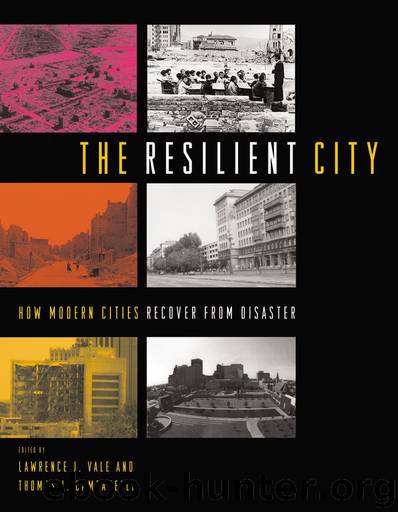The Resilient City by Lawrence J. Vale

Author:Lawrence J. Vale
Language: eng
Format: epub
Publisher: Oxford University Press
Published: 2005-03-02T16:00:00+00:00
The second reaction to the loss of the temple might be called envisioning. Here substitution takes the form of dreaming of an alternative more perfect than the one lost. In the book of Ezekiel, the prophet, in exile in Babylon, writes about being put down on a mountain with a city to the south, from which he was guided by a man with a measuring line and rod in his hand. There follow seven chapters of detailed measurements of an imagined temple. Ezekiel’s temple is a plan of elementary geometry and composition, removed from any actual site. The many attempts to reconstruct Ezekiel’s vision stress ideality and abstraction, the plan’s symmetry and perfection, and its nine-squares formula. One of the most famous of these reconstructions was by the sixteenth-century Jesuit scholar Villalpandus, who, conflating it with Solomon’s temple, argued that, having been designed by God, the temples were perfect and, as a consequence, only the classical building style was appropriate.47
The third response to the loss of the temple and the homeland can be called social reinforcement. How does an exiled community hold itself together when faced with assimilation and disappearance? Babylon had many attractions: it had already been destroyed four times but had been splendidly rebuilt.48 It was the largest city since the beginning of history, its buildings admired as wonders of the world. Jews were allowed to prosper and many did, even serving in Babylonian public offices.49 To survive as Jews, they had to become more precise about themselves, and the prophets helped in this definition. In Babylonian exile, the Judeans recovered an emphasis on the Torah, the five books that contain God’s directions for life, so that when the Jews returned to Israel through the good graces of the Persian king Cyrus, the Torah was renewed as the normative law of the Jews.50 When the priest and scribe Ezra returned to Jerusalem from Babylon in the fifth century B.C., he read from the Torah of Moses to the people for the first time in public, and “all the people wept, when they heard the words of the law.”51 The Babylonian experience remained a formative one for the Jews. About 1,000 years after the exile, the codification of Jewish oral law was complete. There are two versions—the Jerusalem Talmud and the Babylonian Talmud—the latter of which is widely regarded as the more complete and authoritative.52
The rebuilding of the temple upon the Jewish return to Jerusalem was modest. At its inauguration in 515 B.C., only about 700 animals were sacrificed. But some 300 years later, in 169 B.C., even this humble building was desecrated by the Seleucid king Antiochus IV, whose troops pillaged it, burning the Scroll of the Law and erecting a statue of Zeus and a pagan altar on the site.53 Despite later attempts to build walls to protect the temple, it was destroyed by the Roman emperor Pompey in 63 B.C.
Pompey’s carnage foreshadowed the Roman destruction of the last and grandest of the Jewish temples about a century later.
Download
This site does not store any files on its server. We only index and link to content provided by other sites. Please contact the content providers to delete copyright contents if any and email us, we'll remove relevant links or contents immediately.
The Secret History by Donna Tartt(16623)
The Social Justice Warrior Handbook by Lisa De Pasquale(11489)
Thirteen Reasons Why by Jay Asher(7788)
This Is How You Lose Her by Junot Diaz(5772)
Weapons of Math Destruction by Cathy O'Neil(5037)
Zero to One by Peter Thiel(4824)
The Myth of the Strong Leader by Archie Brown(4789)
Promise Me, Dad by Joe Biden(4447)
Beartown by Fredrik Backman(4419)
Stone's Rules by Roger Stone(4415)
How Democracies Die by Steven Levitsky & Daniel Ziblatt(4399)
The Fire Next Time by James Baldwin(4343)
100 Deadly Skills by Clint Emerson(4078)
A Higher Loyalty: Truth, Lies, and Leadership by James Comey(4033)
Rise and Kill First by Ronen Bergman(4012)
The David Icke Guide to the Global Conspiracy (and how to end it) by David Icke(3882)
The Farm by Tom Rob Smith(3872)
Secrecy World by Jake Bernstein(3782)
The Doomsday Machine by Daniel Ellsberg(3731)
